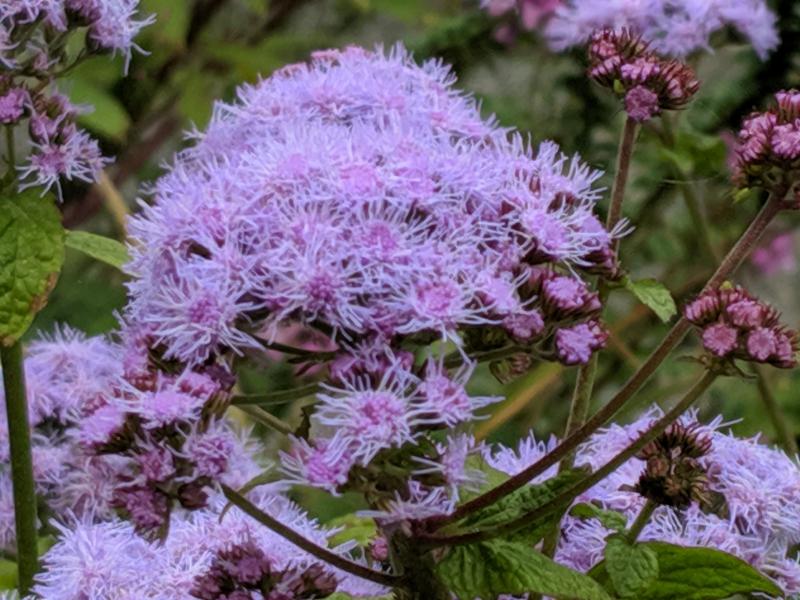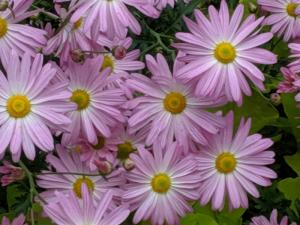Mill Pond Garden will be open from 10 a.m. to 1 p.m., Sunday, Oct. 11, featuring chrysanthemums, asters and mist flowers as the stars of the autumn garden. To subscribe for invitations to request tickets and rain date notification, go to millpondgarden.com.
The chrysanthemum, aster, and mist flower are perennials that bloom every year and are important for pollinators. Chrysanthemums symbolize longevity. Ironically, most of the chrysanthemums now bred and sold in the autumn in the local area are not winter-hardy; they only bloom for two weeks and are not visited by pollinators. Only the long-lived perennial chrysanthemums help pollinators.
Some local nurseries and greenhouses still offer a few hardy chrysanthemums. Homeowners are unlikely to find any hardy chrysanthemums in the big-box stores, except the Montauk daisy. They can search for hardy chrysanthemums online for more choices and information; however, many of the varieties offered there may not survive the Cape Region’s humidity and hot summers, or the occasionally very cold winter spells. The ones recommended by Mill Pond Garden have proven reliable through many years. MPG founder Mike Zajic said, “We’ve tried a great many types. Some lasted a couple years, but we have winnowed our list down to the best of the best that can be relied on.”
One might find colorful, hardy Chrysanthemum morifolium in old local gardens that have been growing here for many decades and possibly persuade the owner to provide a cutting or piece of the root stock. Gardeners usually like to share. Cuttings can be rooted easily in late summer or early fall by using rooting hormone, available in most garden centers. The type of cutting most likely to succeed is four inches long from mid-stem, with some leaves, taken in early October.
The old-fashioned hardy chrysanthemums featured at Mill Pond Garden bloom about three times as long as the non-hardy varieties. Two of the best to grow here are Chrysanthemum dendranthema Sheffield Pink and Cambodian Queen.
Sheffield Pink Chrysanthemum is the latest-blooming, from November into mid-December. Easy-to-grow Cambodian Queen Chrysanthemum has extra-large pink daisy flowers blooming in October and November. Both are robust and disease free.
Nippon daisy, a Japanese chrysanthemum often called Montauk daisy, is prized for its shape, handsome foliage, and late-season explosion of perky white flowers. This easy-care plant grows 24 to 36 inches tall, and thrives in full sun and well-drained soil in Zones 5-9. Both the leaves and flowers of Nippon daisy are frost tolerant and will retain their color right up until a hard freeze. The nectar-rich blooms will also lure colorful butterflies to the garden. Nippon daisy is deer-resistant, too.
The secret to success with chrysanthemums is good drainage, compost enriched soil, and lots of sun. Note that all mums and asters hate lime in the soil. When growing hardy chrysanthemums or asters in the Cape Region, gardeners should be sure to pinch the tips back halfway about June 7, and again, about three inches off the top, about July 1, for bushier growth.
There are several native asters, common name Michaelmas daisies, now renamed Symphyotrichum, including New England aster and the locally native frost aster, Symphyotrichum pilosum. Mill Pond Garden recommends using this native aster, which grows as a common weed here. Such local weeds’ flowers and nectar are what pollinators and insects most depend on for survival, so they should not be despised.
The native frost aster bears small white flowers with gold button centers and blooms from late September to late October, when many species of bees most need nectar. The frost aster is not for sale in local nurseries, but it can be ordered online or found locally in the wild, possibly already in your own yard. It can also be purchased at Mill Pond Garden. It increases rapidly, as do all native asters. These late-flowering asters are a key to the survival of some 200 species of native bees.
Another perennial worth growing is Aster Frikartii Monch, a sky-blue, disease-resistant aster that blooms from late June to late September, best in full sun.
Care for hardy chrysanthemums and asters should include placement for six hours or more of full sun, a site with good drainage and lime-free, compost-enriched soil, and application of a balanced organic fertilizer in late winter and again in mid-spring.
Another jewel of the autumn garden is the native purple mist flower, Euphorbia conclinium, which grows about two feet high. Enjoy this in a sunny spot. It will also tolerate moist soils, unlike most mums and asters. Mist flower will thrive and bloom beautifully for pollinators for three weeks in early through mid-autumn. Bumblebees adore it.
Mill Pond Garden, located at 31401 Melloy Court, Lewes, is a holistic botanical garden and a National Wildlife Federation-certified Wildlife Habitat on Red Mill Pond. It features constantly changing seasonal displays that show what grows best in the Cape Region, and habitats and plants that prosper sustainable, biological diversity. Horticultural expertise is available on open garden days.




















































